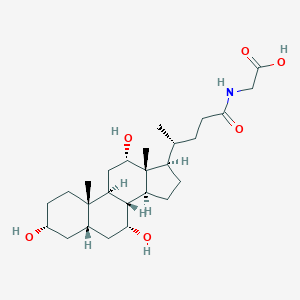| General Information of MET (ID: META00175) |
| Name |
Glycocholic acid
|
| Synonyms |
Click to Show/Hide Synonyms of This Metabolite
3alpha,7alpha,12alpha-Trihydroxy-5beta-cholan-24-oylglycine; 3alpha,7alpha,12alpha-Trihydroxy-5beta-cholanic acid-24-glycine; Cholylglycine; Glycine cholate; Glycocholate; Glycocholate sodium; Glycocholic acid; Glycocholic acid, sodium salt; Glycoreductodehydrocholic acid; Glycylcholate; Glycylcholic acid; N-Choloyl-glycine; N-Choloylglycine; N-[(3alpha,5beta,7alpha,12alpha)-3,7,12-Trihydroxy-24-oxocholan-24-yl]glycine
|
| Source |
Endogenous;Food
|
| Structure Type |
Bile acids, alcohols and derivatives (Click to Show/Hide the Complete Structure Type Hierarchy)
Lipids and lipid-like molecules
Steroids and steroid derivatives
Bile acids, alcohols and derivatives
|
| PubChem CID |
|
| HMDB ID |
|
| Formula |
C26H43NO6
|
| Structure |
<iframe style="width: 300px; height: 300px;" frameborder="0" src="https://embed.molview.org/v1/?mode=balls&cid=10140"></iframe>
|
 |
|
3D MOL
|
2D MOL
|
|
Click to Show/Hide the Molecular/Functional Data (External Links/Property/Function) of This Metabolite
|
| KEGG ID |
|
| ChEBI ID |
|
| FooDB ID |
|
| ChemSpider ID |
|
| Physicochemical Properties |
Molecular Weight |
465.6 |
Topological Polar Surface Area |
127 |
| XlogP |
2.9 |
Complexity |
759 |
| Heavy Atom Count |
33 |
Rotatable Bond Count |
6 |
| Hydrogen Bond Donor Count |
5 |
Hydrogen Bond Acceptor Count |
6 |
| Function |
Glycocholic acid is an acyl glycine and a bile acid-glycine conjugate. It is a secondary bile acid produced by the action of enzymes existing in the microbial flora of the colonic environment. Bacteroides, Bifidobacterium, Clostridium and Lactobacillus are involved in bile acid metabolism and produce glycocholic acid. In hepatocytes, both primary and secondary bile acids undergo amino acid conjugation at the C-24 carboxylic acid on the side chain, and almost all bile acids in the bile duct therefore exist in a glycine conjugated form. More specifically, glycocholic acid or cholylglycine, is a crystalline bile acid involved in the emulsification of fats. It occurs as a sodium salt in the bile of mammals. Its anion is called glycocholate. As the glycine conjugate of cholic acid, this compound acts as a detergent to solubilize fats for absorption and is itself absorbed (PubChem). Bile acids are steroid acids found predominantly in bile of mammals. The distinction between different bile acids is minute, depends only on presence or absence of hydroxyl groups on positions 3, 7, and 12. Bile acids are physiological detergents that facilitate excretion, absorption, and transport of fats and sterols in the intestine and liver. Bile acids are also steroidal amphipathic molecules derived from the catabolism of cholesterol. They modulate bile flow and lipid secretion, are essential for the absorption of dietary fats and vitamins, and have been implicated in the regulation of all the key enzymes involved in cholesterol homeostasis. Bile acids recirculate through the liver, bile ducts, small intestine and portal vein to form an enterohepatic circuit. They exist as anions at physiological pH and, consequently, require a carrier for transport across the membranes of the enterohepatic tissues. The unique detergent properties of bile acids are essential for the digestion and intestinal absorption of hydrophobic nutrients. Bile acids have potent toxic properties (e.g., membrane disruption) and there are a plethora of mechanisms to limit their accumulation in blood and tissues. Glycocholic acid is found to be associated with alpha-1-antitrypsin deficiency, which is an inborn error of metabolism.
|
|
Regulatory Network
|
|
|
|
|
|
|
|
|
 click to show the details of this protein
click to show the details of this protein
 click to show the details of experiment for validating this pair
click to show the details of experiment for validating this pair

